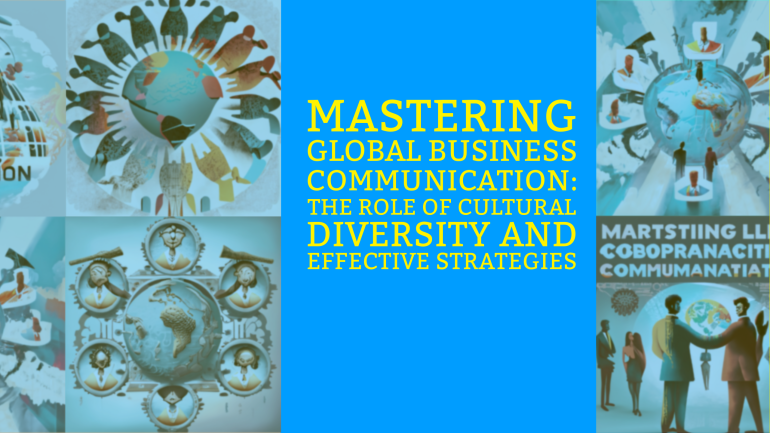This website uses cookies so that we can provide you with the best user experience possible. Cookie information is stored in your browser and performs functions such as recognising you when you return to our website and helping our team to understand which sections of the website you find most interesting and useful.
Mastering Global Business Communication: The Role of Cultural Diversity and Effective Strategies
Table of Contents
TL;DR: The Influence of Cultural Diversity on Business Communication
- Cultural Diversity Enriches Businesses: Brings together unique perspectives, enhancing creativity and innovation.
- Effective Communication is Crucial: Overcoming language barriers and understanding non-verbal cues are essential for success.
- Inclusivity and Training Improve Outcomes: Creating an inclusive environment and investing in cross-cultural training can significantly enhance workplace harmony and productivity.
- Adaptability to Communication Styles Matters: Recognizing and adapting to different cultural communication styles is key for international business success.
Introduction
Have you ever considered how the rich tapestry of global cultures shapes the way we communicate within the business world? Cultural diversity in the workplace is not just a backdrop; it’s the very stage upon which modern business practices perform. In an era where business dealings span continents in mere seconds, the importance of effective communication within this diverse setting cannot be overstated.
Understanding Cultural Diversity
The Concept of Cultural Diversity
So, what is cultural diversity? Imagine a world where every business interaction is a journey across a vast mosaic of human experience. Cultural diversity represents this mosaic, comprised of individuals from varied backgrounds, beliefs, and traditions, each contributing their unique piece to the overall picture. It’s about acknowledging, appreciating, and leveraging these differences to foster a rich, dynamic business environment.
The Importance of Cultural Awareness in Business
Why should we care about cultural awareness in business? Because, at its heart, business is a human endeavor. Understanding the cultural dimensions of your colleagues, clients, and business partners can mean the difference between success and failure. It’s about connecting on a human level, transcending language and geographic boundaries to build relationships founded on mutual respect and understanding.

The Impact of Cultural Diversity on Communication
Language Barriers and Misinterpretations
Ever played a game of telephone? It’s fun until the message gets lost in translation. Now, apply that to a business setting—misunderstandings can lead to errors, missed opportunities, and even conflict. Overcoming language barriers and avoiding misinterpretations are crucial. Solutions like employing translators, using clear and simple language, and fostering an environment where questions are encouraged can bridge the gap.
Non-Verbal Communication Across Cultures
But what about the things we say without words? Non-verbal cues like gestures, facial expressions, and body language can vary dramatically between cultures. What’s considered polite in one culture might be rude in another. Understanding these nuances is key to avoiding misunderstandings and building stronger relationships.
Strategies for Enhancing Communication in a Diverse Workplace
Fostering an Inclusive Environment
Creating a workplace that feels welcoming to everyone is like setting the table for a feast; it encourages everyone to bring their best dishes. Inclusivity isn’t just about policies; it’s about creating a culture where everyone feels valued and heard. Simple measures like celebrating different cultural holidays and encouraging the sharing of different cultural perspectives can make a big difference.
The Role of Cross-Cultural Training
Imagine being equipped with a cultural compass, guiding you through the complexities of international business communication. Cross-cultural training provides this compass, offering strategies and insights to navigate the diverse landscape of global business. Such training can enhance empathy, reduce misunderstandings, and improve overall communication efficacy.
Real-World Examples of Cultural Diversity Improving Business Communication
From multinational corporations to small businesses reaching out to new markets, embracing cultural diversity has proven to be a boon. Case studies from companies like Google, IBM, and Coca-Cola show that a diverse workforce not only fosters creativity and innovation but also enhances global reach and understanding, leading to better customer relationships and business outcomes.
Overcoming Challenges
Addressing Cultural Conflicts
Conflict is a natural part of any human interaction, but in a culturally diverse setting, it can arise from misunderstandings or differing viewpoints. Addressing these conflicts openly and respectfully, seeking to understand before being understood, can turn potential obstacles into opportunities for growth and learning.
Adapting to Different Communication Styles
Each culture has its own communication style, from the directness of some Western cultures to the more indirect and harmonious approaches seen in many Eastern cultures. Recognizing and adapting to these styles can prevent miscommunications and foster a more harmonious work environment.
The Future of Business Communication in a Culturally Diverse World
As the world becomes increasingly interconnected, the ability to communicate effectively across cultural lines will become ever more critical. The businesses that thrive will be those that embrace this diversity, seeing it not as a barrier but as a bridge to new opportunities and insights.
Conclusion
In wrapping up, it’s clear that the influence of cultural diversity on business communication is profound and far-reaching. Embracing this diversity, with all its complexities, can enrich our business interactions and lead to more meaningful, successful outcomes. Let’s continue to break down barriers and build bridges, fostering a global business community that thrives on mutual understanding and respect.
FAQs
Q1: What exactly is cultural diversity in the business context?
A1: Cultural diversity in the business context refers to the inclusion of employees from various cultural, ethnic, and racial backgrounds within an organization. It emphasizes the value of diverse perspectives and experiences in enhancing creativity, problem-solving, and decision-making processes.
Q2: Why is effective communication crucial in culturally diverse workplaces?
A2: Effective communication is crucial in culturally diverse workplaces because it bridges the gap between different cultural understandings and practices. It ensures that all team members are on the same page, reduces the risk of misunderstandings, and fosters a more inclusive and productive work environment.
Q3: How can businesses overcome language barriers effectively?
A3: Businesses can overcome language barriers by implementing language training programs, employing multilingual staff, using translation services, and encouraging clear and simplified communication. Creating a culture that promotes patience and understanding also helps in mitigating these challenges.
Q4: What role does non-verbal communication play in different cultures?
A4: Non-verbal communication plays a significant role in different cultures as it can convey messages and emotions without the use of words. Gestures, body language, facial expressions, and eye contact vary greatly across cultures and can influence how messages are interpreted. Understanding these differences is essential for effective cross-cultural communication.
Q5: Can cultural diversity impact business success?
A5: Yes, cultural diversity can significantly impact business success. It brings a wealth of perspectives and ideas, fostering innovation and creativity. Diverse teams are better equipped to understand and serve global markets, leading to improved customer satisfaction and business growth. Additionally, an inclusive culture attracts top talent from various backgrounds, enhancing the company’s reputation and competitiveness.





